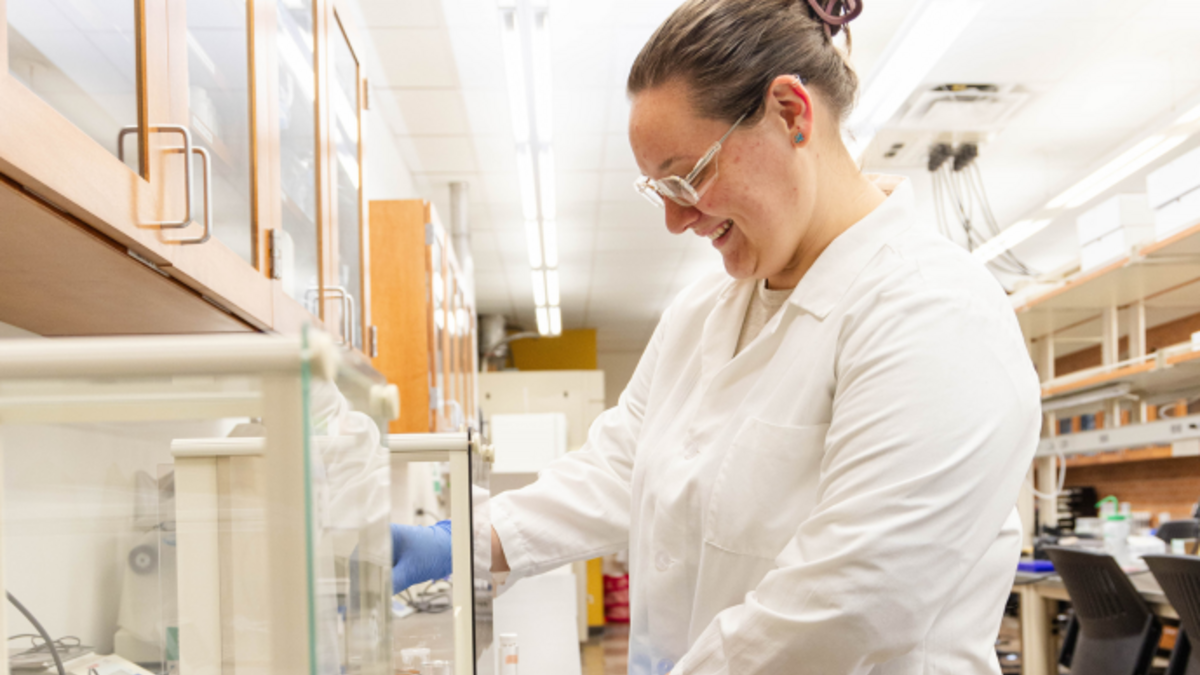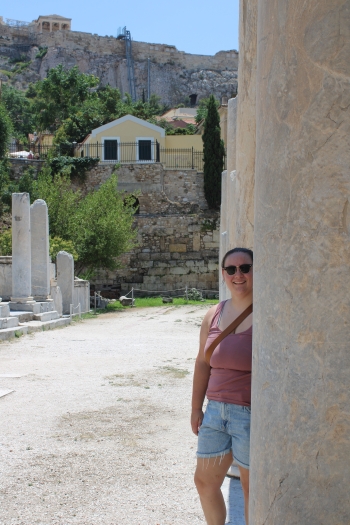Tooth enamel helps unravel mystery of ancient Greek cemetery

Julianne Stamer working in the Archaeological Chemistry Laboratory on ASU's Tempe campus. Photo by Meghan Finnerty/The College
An ASU PhD candidate is working to piece together the lives of people who were found buried in shackles in a Greek cemetery through the study of teeth.
The Phaleron cemetery was first discovered in the early 1900s and contains the remains of children, shackled men and even animals. The site was dated using pottery to the Archaic period in Athens, between the 8th and 7th centuries B.C.
Major excavations happened from 2012–16 by Greek archaeologist Stella Chrysoulaki, but despite the excavation, answers to many questions — including the identities of those found in shackles — remained.
To help answer these questions, experts turned to Arizona State University, and the Phaleron Bioarchaeological Project was created.
The project is directed by ASU Regents Professor Jane Buikstra and currently includes the work of ASU professors Kelly Knudson and Chris Stojanowski, as well as that of PhD candidate Julianne Stamer.
“We have many supporters and collaborators from across the U.S. and Europe, including scientists and humanists, which makes this a challenging but rewarding experience,” Buikstra said. “We have a number of graduate students and early career professionals involved, which is always energizing.”
Now, as part of the project, Stamer is writing a portion of her dissertation about a mass grave that contains three rows of individuals buried at the site of the Phaleron cemetery.
The 'Esplanada'
Anthropologists and archaeologists have termed the three graves "Esplanada."
Stamer will also compare the individuals at the Esplanada to others buried in different parts of the cemetery.
The Esplanada contains the remains of 79 shackled people believed to be victims of political violence. Some are shackled above their heads, some at their feet. Scientists have done a basic age and sex profile on the remains, and it is believed they are young men, Stamer said.
“We are getting back preliminary data on the residential history of the individuals of the site — this means we used strontium stable isotope analysis to assess if individuals buried at Phaleron were born near Athens or not,” she said.
With help from ASU’s Metals, Environmental and Terrestrial Analytical Laboratory, or METAL, Stamer is analyzing strontium in tiny samples from the men’s tooth enamel.
Stamer says that she does this with extreme care and respect for the people buried and that she is working with the Greek government.
Before Stamer takes any enamel, she makes 3D models of the teeth, documents all her work and has to comply with permits. She also said the samples she uses will be returned to Greece when she is finished; ASU doesn’t keep any of the tooth enamel.
The science
With help from METAL, Stamer takes about 30 milligrams of tooth enamel, which is equivalent to roughly 100 grains of sand or less.
Teeth can show your entire life story, Stamer says.
Tooth enamel is different from your bones. Enamel forms during early childhood, and it doesn’t remodel or repair when you chip or break your tooth. Bones however, repair themselves, and over the course of your life, the cells and mineral content turn over; soour bones can only usually show the last seven years of our life.
“From the time your teeth are formed as a baby, they have the same mineral content,” Stamer said. “One of the minerals inside is strontium — a metal that has multiple stable isotopes that have different weights based on their atomic number.
“Strontium is found in nature, and we also find these in soil and water. Strontium isotopes vary based on the type of soil or the type of rock that they came from. So what we are really doing is saying the ratio of the heavier isotope strontium to the lighter isotope strontium overlaps with what we expect the local geology of Athens to look like.”
METAL at ASU includes state-of-the-art technology for bioarchaeologists to conduct research.
For more than 20 years, the lab has developed specialized methods and customizations specifically for anthropology, said Gwyneth Gordon, manager of the lab and assistant research professor at the School of Earth and Space Exploration.
“We have a hood in our trace metal clean laboratory that is dedicated to our anthropology researchers, certified standards designed around common sample types like bone and tooth enamel — and have customized analytical workflows to get the highest possible data quality for anthropologists,” Gordon said. “We also have two Prepfast-MC instruments that automate the sample preparation for strontium isotopes of tooth enamel. We worked with the company to validate its use for specifically these applications.”
Stamer has been working on the project since 2020 and is hoping to finish her laboratory analysis this coming school year. She also explained that other researchers on the project are working on ancient DNA (aDNA) — however, to date, there has been no aDNA recovered from the Esplanada individuals.
For Stamer, this work is more than a dissertation.
“I think we have a lot we can learn about the men buried at the Esplanada,” she said.
“I think we can learn empathy for people in different times and places. We can learn how similar we are to others, yet how different we are. People like to hear about history and classical studies. Bioarchaeology adds a very humanistic side to that classical literature.”
More Science and technology

Breakthrough copper alloy achieves unprecedented high-temperature performance
A team of researchers from Arizona State University, the U.S. Army Research Laboratory, Lehigh University and Louisiana State University has developed a groundbreaking high-temperature copper alloy…

4 ASU researchers named senior members of the National Academy of Inventors
The National Academy of Inventors recently named four Arizona State University researchers as senior members to the prestigious organization.Professor Qiang Chen and associate professors Matthew…

Transforming Arizona’s highways for a smoother drive
Imagine you’re driving down a smooth stretch of road. Your tires have firm traction. There are no potholes you need to swerve to avoid. Your suspension feels responsive. You’re relaxed and focused on…


